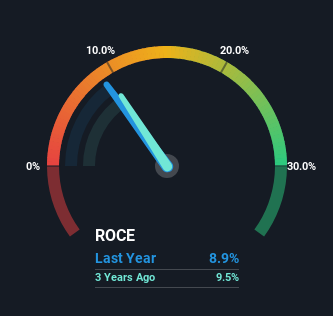- Hong Kong
- /
- Electronic Equipment and Components
- /
- SEHK:3969
Returns On Capital Signal Tricky Times Ahead For China Railway Signal & Communication (HKG:3969)

Finding a business that has the potential to grow substantially is not easy, but it is possible if we look at a few key financial metrics. One common approach is to try and find a company with returns on capital employed (ROCE) that are increasing, in conjunction with a growing amount of capital employed. If you see this, it typically means it's a company with a great business model and plenty of profitable reinvestment opportunities. Although, when we looked at China Railway Signal & Communication (HKG:3969), it didn't seem to tick all of these boxes.
Return On Capital Employed (ROCE): What Is It?
If you haven't worked with ROCE before, it measures the 'return' (pre-tax profit) a company generates from capital employed in its business. Analysts use this formula to calculate it for China Railway Signal & Communication:
Return on Capital Employed = Earnings Before Interest and Tax (EBIT) ÷ (Total Assets - Current Liabilities)
0.089 = CN¥4.7b ÷ (CN¥117b - CN¥65b) (Based on the trailing twelve months to December 2023).
Thus, China Railway Signal & Communication has an ROCE of 8.9%. On its own that's a low return on capital but it's in line with the industry's average returns of 8.5%.
Check out our latest analysis for China Railway Signal & Communication

In the above chart we have measured China Railway Signal & Communication's prior ROCE against its prior performance, but the future is arguably more important. If you'd like to see what analysts are forecasting going forward, you should check out our free analyst report for China Railway Signal & Communication .
What Does the ROCE Trend For China Railway Signal & Communication Tell Us?
In terms of China Railway Signal & Communication's historical ROCE movements, the trend isn't fantastic. To be more specific, ROCE has fallen from 14% over the last five years. Meanwhile, the business is utilizing more capital but this hasn't moved the needle much in terms of sales in the past 12 months, so this could reflect longer term investments. It's worth keeping an eye on the company's earnings from here on to see if these investments do end up contributing to the bottom line.
On a side note, China Railway Signal & Communication's current liabilities are still rather high at 55% of total assets. This effectively means that suppliers (or short-term creditors) are funding a large portion of the business, so just be aware that this can introduce some elements of risk. Ideally we'd like to see this reduce as that would mean fewer obligations bearing risks.
The Bottom Line
To conclude, we've found that China Railway Signal & Communication is reinvesting in the business, but returns have been falling. And investors appear hesitant that the trends will pick up because the stock has fallen 38% in the last five years. On the whole, we aren't too inspired by the underlying trends and we think there may be better chances of finding a multi-bagger elsewhere.
One more thing to note, we've identified 1 warning sign with China Railway Signal & Communication and understanding it should be part of your investment process.
While China Railway Signal & Communication isn't earning the highest return, check out this free list of companies that are earning high returns on equity with solid balance sheets.
New: AI Stock Screener & Alerts
Our new AI Stock Screener scans the market every day to uncover opportunities.
• Dividend Powerhouses (3%+ Yield)
• Undervalued Small Caps with Insider Buying
• High growth Tech and AI Companies
Or build your own from over 50 metrics.
Have feedback on this article? Concerned about the content? Get in touch with us directly. Alternatively, email editorial-team (at) simplywallst.com.
This article by Simply Wall St is general in nature. We provide commentary based on historical data and analyst forecasts only using an unbiased methodology and our articles are not intended to be financial advice. It does not constitute a recommendation to buy or sell any stock, and does not take account of your objectives, or your financial situation. We aim to bring you long-term focused analysis driven by fundamental data. Note that our analysis may not factor in the latest price-sensitive company announcements or qualitative material. Simply Wall St has no position in any stocks mentioned.
About SEHK:3969
China Railway Signal & Communication
Provides rail transportation control system solutions in China and internationally.
Excellent balance sheet with moderate growth potential.
Similar Companies
Market Insights
Community Narratives




